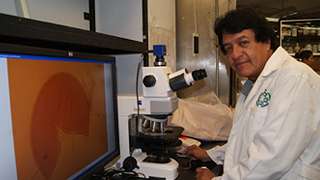Bacteria enhance growth of fruit trees up to 40 percent

Improvement in reforestation and agriculture is possible thanks to the work of scientists in the Center of Research and Advanced Studies (Cinvestav) who use different strains of fungi and bacteria to promote development and health in trees, which have enabled them to accelerate growth of different species up to 40 percent.
According to researcher Víctor Olalde Portugal, responsible for the project, one of the challenges of the reforestation systems is to achieve the survival of the species when planted. Hence, the importance of microorganisms that provide benefits to the trees, for example, increasing their development, giving more stability when transplanted and providing water to the subsoil in situations of drought.
"We proved that in a period of three years oaks, pines, mesquites and acacias between two and three meters high can be obtained, which generally occurs in six or seven years. When this process is applied to fruit trees (citrus, guava or lemon), fruit development is reached in three or four years, which normally happens at six" says the researcher of the Department of Biotechnology and Biochemistry of the Cinvestav.
He also explains that the beneficial bacteria are located in the immediate area surrounding the root or rhizosphere, and among these bacteria are a group classified as "growth promoters", which fulfill the function of helping the plant development and protect it from the attack of pathogenic microorganisms or by producing phytohormones; these substances allow a supply of nutrients and water.
The fungi that provide benefits, says Olalde Portugal, are the called myccorrhizal. When in contact with the roots a biochemical communication starts that allows the trees to adapt with no problems when transplanted. Besides, the microorganism is responsible for exploring the ground beyond the reach of the roots and brings them useful elements for their development, like phosphorus.
In addition, the specialist stresses that the plant with myccorrhizal fungi perform photosynthesis in a more efficient way, using less water than those who don't have the association. At the same time, all physiological processes change, resulting in rapid developing trees.
However, not all bacteria or fungi perform with the same efficiency. "For this reason, a very important part of the research consisted in selecting the best strains specific for oaks, pines, mesquites, acacias and fruit trees. Afterwards, we looked for the ideal conditions to impulse their massive propagation", says the expert.
He adds that they are not only focusing in reforestation with timber species, but also with agave and nopal, that are specific to arid areas. This part of the project is done in collaboration with Guanajuato University.
The group of scientist headed by Olalde Portugal has obtained native strains from Guanajuato, although it has been successfully tested in adjacent states. The specialist exposed that with this finding they expect to make technological packages that can be transferred to a company interested in the development of this alternative from agrochemicals or to associate with nursery producers.
Provided by Investigacion y Desarrollo

















